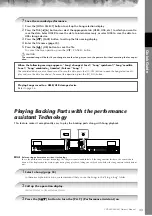
Quic
k Guide
CVP-405/403/401 Owner’s Manual
39
Set the detailed parameters of the view type as desired.
1
Press the [8
π
π
π
π†
†
†
†
] (SETUP) button to call up the detailed setting display.
2
Press the [1
π
π
π
π†
†
†
†
]–[6
π
π
π
π†
†
†
†
] buttons to set the view type.
3
Press the [8
π
π
π
π
] (OK) button to apply the setting.
n
Save the notation view settings
The notation view settings can be saved as part of a Song (page 158).
One-handed Practice with the Guide Lamps
The key guide lamps indicate the notes you should play, when you should play them, and how long you should hold
them down. You can also practice at your own pace—since the accompaniment waits for you to play the notes cor-
rectly. Here, mute the right- or left-hand part and try practicing the part using the guide lamps.
Practicing the Right-hand Part (TRACK 1) Using the Guide Lamps
LEFT CH/RIGHT CH
Determines which MIDI channel in the Song data is used for the left-hand/right-hand part. This set-
ting returns to AUTO when a different Song is selected.
AUTO
The MIDI channels in the Song data for the right- and left-hand parts are assigned automatically—
setting the parts to the same channel as the channel which is specified in the [FUNCTION]
→
[B] SONG SETTING.
1–16
Assigns the specified MIDI channel (1–16) to each of the left- and right-hand parts.
OFF (LEFT CH only)
No channel assignment: This disables display of the left-hand key range.
KEY SIGNATURE
This lets you enter key signature changes in the middle of a song, at the stopped position. This menu
is useful when the selected Song contains no key signature settings for displaying notation.
QUANTIZE
This gives you control over the note resolution in the notation, letting you shift or correct the timing
of all displayed notes so that they line up to a particular note value. Make sure to select the smallest
note value used in the song.
NOTE NAME
Selects the type of the note name indicated at the left of the note in the notation from among the fol-
lowing three types. The settings here are available when the NOTE parameter in “Display the note
name at the left of the note” step 1 is set to ON.
A, B, C
Note names are indicated as letters (C, D, E, F, G, A, B).
FIXED DO
Note names are indicated in solfeggio and differ depending on the selected language.
The language is specified in LANGUAGE of the OWNER display (page 63).
MOVABLE DO
Note names are indicated in solfeggio according to the scale intervals, and as such are relative to the
key. The root note is indicated as Do. For example, in the key of G major the root note of “So” would
be indicated as “Do.” As with “Fixed Do,” the indication differs depending on the selected language.
1
2
Turn the [GUIDE] button on.
2
3
4
















































